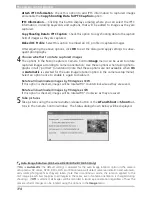
126
The Camera Control Window
The Exposure 2 Tab
The following settings can be adjusted from
the Exposure 2 tab.
Focus Area
: The focus area can be selected us-
ing the arrow buttons; see the camera manual
for details. For information on AF-area mode
and focus mode, see “The Mechanical Tab”
(
128).
Metering Mode
: The metering mode can be
selected from this menu (D2 series, D200,
D70s, D70, and D50 only). Metering mode
defaults to the option selected with the
camera. If a D1-series or D100 camera is
connected, or if
Enable controls on the
camera body
is checked when a D2-series
or D200 camera is connected, the current
metering mode will be shown, but changes
can only be made using camera controls. See
the camera manual for details.
Flash Sync Mode
: This option controls the camera fl ash sync mode.
Sensitivity
: Sensitivity (ISO equivalency) can be raised when taking photographs in low light
conditions. See the user’s manual provided with your camera for details.
Auto
(D2 series/D200/D100/D70s/D70/D50 only): When this option is checked, the camera
will adjust sensitivity (ISO equivalency) au to mat i cal ly (ISO auto).
White Balance
: White balance is used to ensure that colors which appear white when viewed
directly are white in the fi nal photograph. It can also be used to produce an intentionally
unbalanced rendering of a scene. See the camera manual for details.
Fine Tune… /Set Temp…
(D2 series/D1 series/D200/D100/D70s/D70 only): Click
Fine Tune…
to make fi ne adjustments to white balance (
133). If
Choose color temp.
is selected (D2
series and D200 only), this button will be labeled
Set temp…
. Click this button to choose a
color temperature (
133). Fine tuning is not available with preset white balance.
Comment
(D2 series/D200 only): This fi eld
lists the comments for all white balance pre-
sets. Clicking
Edit…
when
Preset
is selected
for white balance
displays the dialog shown
at right, where the comments for each of the
white balance presets can be edited. Click
OK
to copy the comments to the camera. Com-
ments can be up to thirty-six characters long and contain letters, numbers, quotes, apostro-
phes, spaces, and any of the following characters: “,” “.” “!” “?” “#” “$” “%” “&” “(” “)”
“[” “]” “{” “}” “*” “+” “-” “/” “:” “;” “<” “=” “>” “_” and “@”.
D70
Summary of Contents for 4DIF
Page 1: ...En Ver 4 4 En Ver 4 4 ...
Page 10: ...6 ...














































